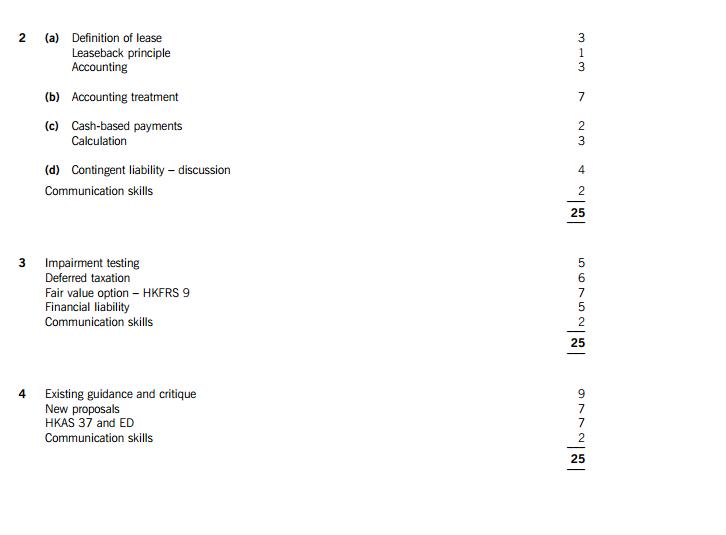3. To improve measurement of liabilities in HKAS 37. The requirements for measuring liabilities are unclear. As a
result, entities use different measures, making it difficult for analysts and investors to compare their financial
statements. Two aspects are particularly unclear. HKAS 37 requires entities to measure liabilities at the ‘best
estimate’ of the expenditure required to settle the obligation. In practice, there are different interpretations of what
‘best estimate’ means: the most likely outcome, the weighted average of all possible outcomes or even the
minimum or maximum amount in the range of possible outcomes. It does not specify the costs that entities should
include in the measurement of a liability. In practice, entities include different costs. Some entities include only
incremental costs while others include all direct costs, plus indirect costs and overheads, or use the prices they
would pay contractors to fulfil the obligation on their behalf.
(ii) The IASB has decided that the new IFRS will not include the ‘probability of outflows’ criterion. Instead, an entity should
account for uncertainty about the amount and timing of outflows by using a measurement that reflects their expected
value, i.e. the probability-weighted average of the outflows for the range of possible outcomes. Removal of this criterion
focuses attention on the definition of a liability in the Framework, which is a present obligation of an entity arising from
past events, the settlement of which is expected to result in an outflow from the entity of resources embodying economic
benefits. Furthermore, the new IFRS will require an entity to record a liability for each individual cost of a restructuring
only when the entity incurs that particular cost.
The exposure draft proposes that the measurement should be the amount that the entity would rationally pay at the
measurement date to be relieved of the liability. Normally, this amount would be an estimate of the present value of the
resources required to fulfil the liability. It could also be the amount that the entity would pay to cancel or fulfil the
obligation, whichever is the lowest. The estimate would take into account the expected outflows of resources, the time
value of money and the risk that the actual outflows might ultimately differ from the expected outflows.
If the liability is to pay cash to a counterparty (for example to settle a legal dispute), the outflows would be the expected
cash payments plus any associated costs, such as legal fees. If the liability is to undertake a service, for example to
decommission plant at a future date, the outflows would be the amounts that the entity estimates it would pay a
contractor at the future date to undertake the service on its behalf. Obligations involving services are to be measured by
reference to the price that a contractor would charge to undertake the service, irrespective of whether the entity is
carrying out the work internally or externally.
(b) Under HKAS 37, a provision of $105 million would be recognised since this is the estimate of the present obligation. There
will be no profit or loss impact other than the adjustment of the present value of the obligation to reflect the time value of
money by unwinding the discount.
18Under the proposed approach there are a number of different outcomes:
– with no risk and probability adjustment, the initial liability would be recognised at $129 million which is the present
value of the resources required to fulfil the obligation based upon third-party prices. This means that in 10 years the
provision would have unwound to $180 million, the entity will spend $150 million in decommission costs and a profit
of $30 million would be recognised. If there were no market for the dismantling of the platform, then Royan would
recognise a liability by estimating the price that it would charge another party to carry out the service.
– With risk and probability being taken into account, then the expected value would be (40% x $129m + 60% x $140m),
i.e. $135·6m plus the risk adjustment of $5 million, which totals $140·6 million.
– $105 million being the present value of the future cashflows discounted.
The ED suggests within paragraph 36B that the entity should take the lower of:
(a) the present value of the resources required to fulfil the obligation, i.e. $105 million;
(b) the amount that the entity would have to pay to cancel the obligation, for which information is not available here; and
(c) the amount that the entity would have to pay to transfer the obligation to a third party, i.e. $140·6 million incorporating
the administrative costs.
Therefore $105 million should be provided.
The ED makes specific reference to provisions relating to services such as decommissioning where it suggests that the amount
to transfer to a third party would be the required liability, so $140·6 million would be provided.


相关推荐:
ACCA教材辅导讲义——Pilotpapers for F3
更多ACCA考试信息请关注读书人网(http://www.reader8.com/)
ACCA频道(http://www.reader8.com/exam/acca/)